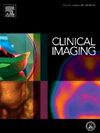Minimizing prostate diffusion weighted MRI examination time through deep learning reconstruction
IF 1.8
4区 医学
Q3 RADIOLOGY, NUCLEAR MEDICINE & MEDICAL IMAGING
引用次数: 0
Abstract
Purpose
To study the diagnostic image quality of high b-value diffusion weighted images (DWI) derived from standard and variably reduced datasets reconstructed with a commercially available deep learning reconstruction (DLR) algorithm.
Materials and methods
This was a retrospective study of 52 patients undergoing conventional prostate MRI with raw image data reconstructed using both conventional 2D Cartesian and DLR algorithms. Simulated shortened DWI acquisition times were performed by reconstructing images using DLR datasets harboring a reduced number of excitations (NEX). Two radiologists independently evaluated the image quality using a 4-point Likert scale. Signal-to-noise ratio (SNR) analysis was performed for the entire cohort and a subset of patients identified as having clinically significant prostate cancer identified at MRI, and later confirmed by pathology.
Results
Radiologists perceived less image noise for both restricted and large field of view (FOV) standard NEX dataset DLR diffusion images compared to conventionally reconstructed images with good interreader agreement. Diagnostic image quality was maintained for all DLR images using variably reduced NEX compared to conventionally reconstructed images employing the standard NEX. Improved signal to noise was observed for the restricted FOV DLR images compared to conventional reconstruction using standard NEX. DLR diffusion images derived from reduced NEX datasets translated to time reductions of up to 68 % and 39 % for the restricted and large FOV series acquisitions, respectively.
Conclusion
DLR of diffusion weighted images can reduce image noise at standard NEX and potentially reduce prostate MRI exam time when utilizing reduced NEX datasets without sacrificing diagnostic image quality.
通过深度学习重建最大限度缩短前列腺弥散加权磁共振成像检查时间
目的:研究使用市售深度学习重建(DLR)算法重建的标准数据集和可变缩小数据集生成的高b值弥散加权图像(DWI)的诊断图像质量:这是一项回顾性研究,研究对象是 52 名接受传统前列腺 MRI 检查的患者,原始图像数据采用传统的二维笛卡尔算法和 DLR 算法重建。通过使用包含较少激发数(NEX)的 DLR 数据集重建图像,模拟缩短了 DWI 采集时间。两名放射科医生使用 4 点李克特量表独立评估图像质量。信噪比(SNR)分析针对的是整个组群,以及在核磁共振成像中被确定为患有临床意义重大的前列腺癌并随后经病理证实的患者子集:与传统的重建图像相比,放射科医生认为限制视野和大视野(FOV)标准 NEX 数据集 DLR 扩散图像的噪声较小,读片者之间的一致性良好。与使用标准 NEX 的传统重建图像相比,使用变异缩小 NEX 的所有 DLR 图像都能保持诊断图像质量。与使用标准 NEX 的传统重建相比,受限 FOV DLR 图像的信噪比有所改善。从缩小的 NEX 数据集中得到的 DLR 扩散图像可使受限 FOV 和大 FOV 系列采集的时间分别缩短 68% 和 39%:弥散加权图像的 DLR 可以减少标准 NEX 的图像噪声,在不影响诊断图像质量的情况下,利用缩小 NEX 数据集有可能缩短前列腺 MRI 检查时间。
本文章由计算机程序翻译,如有差异,请以英文原文为准。
求助全文
约1分钟内获得全文
求助全文
来源期刊

Clinical Imaging
医学-核医学
CiteScore
4.60
自引率
0.00%
发文量
265
审稿时长
35 days
期刊介绍:
The mission of Clinical Imaging is to publish, in a timely manner, the very best radiology research from the United States and around the world with special attention to the impact of medical imaging on patient care. The journal''s publications cover all imaging modalities, radiology issues related to patients, policy and practice improvements, and clinically-oriented imaging physics and informatics. The journal is a valuable resource for practicing radiologists, radiologists-in-training and other clinicians with an interest in imaging. Papers are carefully peer-reviewed and selected by our experienced subject editors who are leading experts spanning the range of imaging sub-specialties, which include:
-Body Imaging-
Breast Imaging-
Cardiothoracic Imaging-
Imaging Physics and Informatics-
Molecular Imaging and Nuclear Medicine-
Musculoskeletal and Emergency Imaging-
Neuroradiology-
Practice, Policy & Education-
Pediatric Imaging-
Vascular and Interventional Radiology
 求助内容:
求助内容: 应助结果提醒方式:
应助结果提醒方式:


